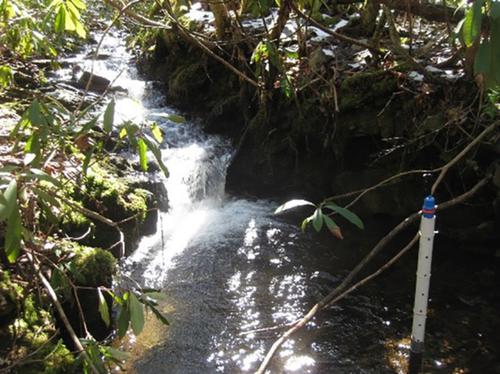当前位置:
X-MOL 学术
›
Hydrol. Process.
›
论文详情
Our official English website, www.x-mol.net, welcomes your
feedback! (Note: you will need to create a separate account there.)
Do southern Appalachian Mountain summer stream temperatures respond to removal of understory rhododendron thickets?
Hydrological Processes ( IF 2.8 ) Pub Date : 2020-05-19 , DOI: 10.1002/hyp.13788 Scott Raulerson 1 , C. Rhett Jackson 1 , Nathan D. Melear 1 , Seth E. Younger 1 , Maura Dudley 2 , Katherine J. Elliott 3
Hydrological Processes ( IF 2.8 ) Pub Date : 2020-05-19 , DOI: 10.1002/hyp.13788 Scott Raulerson 1 , C. Rhett Jackson 1 , Nathan D. Melear 1 , Seth E. Younger 1 , Maura Dudley 2 , Katherine J. Elliott 3
Affiliation

|
Funding information Division of Environmental Biology, Grant/ Award Number: DEB-1637522; Coweeta Hydrologic Laboratory, Southern Research Station, USDA Forest Service Abstract Dense understory thickets of the native evergreen shrub Rhododendron maximum expanded initially following elimination of American chestnut by the chestnut blight, and later in response to loss of the eastern hemlock due to hemlock woolly adelgid invasion. Rhododendron thickets often blanket streams and their riparian zones, creating cool, low-light microclimates. To determine the effect of such understory thickets on summer stream temperatures, we removed riparian rhododendron understory on 300 m reaches of two southern Appalachian Mountain headwater streams, while leaving two 300 m reference reaches undisturbed. Overhead canopy was left intact in all four streams, but all streams were selected to have a significant component of dead or dying eastern hemlock in the overstory, creating time-varying canopy gaps throughout the reach. We continuously monitored temperatures upstream, within and downstream of treatment and reference reaches. Temperatures were monitored in all four streams in the summer before treatments were imposed (2014), and for two summers following treatment (2015, 2016). Temperatures varied significantly across and within streams prior to treatment and across years for the reference streams. After rhododendron removal, increases in summer stream temperatures were observed at some locations within the treatment reaches, but these increases did not persist downstream and varied by watershed, sensor, and year. Significant increases in daily maxima in treatment reaches ranged from 0.9 to 2.6 C. Overhead canopy provided enough shade to prevent rhododendron removal from increasing summer temperatures to levels deleterious to native cold-water fauna (average summer temperatures remained below 16 C), and local temperature effects were not persistent.
中文翻译:

阿巴拉契亚山脉南部夏季溪流温度对林下杜鹃花丛的清除是否有反应?
资助信息环境生物学司,资助/奖励编号:DEB-1637522;Coweeta 水文实验室,美国农业部林业局南部研究站 摘要 原生常绿灌木杜鹃花的茂密林下灌木丛最初在板栗枯萎病消灭美洲板栗后扩大,后来由于铁杉毛状 adelgid 入侵导致东部铁杉损失. 杜鹃花丛通常覆盖溪流及其河岸带,形成凉爽、低光的小气候。为了确定此类林下灌木丛对夏季溪流温度的影响,我们移除了两条阿巴拉契亚山脉南部源头溪流的 300 m 河段上的河岸杜鹃林,同时保留了两个 300 m 参考河段不受干扰。所有四个溪流中的顶篷都完好无损,但所有溪流都被选择在上层中含有大量死亡或垂死的东部铁杉,从而在整个河段形成随时间变化的树冠间隙。我们持续监测处理和参考河段上游、内部和下游的温度。在实施治疗前的夏季(2014 年)和治疗后的两个夏季(2015 年、2016 年),对所有四个溪流的温度进行了监测。处理前和参考流之间的温度在流之间和内部变化很大。去除杜鹃花后,在处理河段内的某些位置观察到夏季溪流温度升高,但这些升高并未在下游持续存在,并且因流域、传感器和年份而异。治疗范围内每日最大值的显着增加范围为 0.9 至 2.6 C。
更新日期:2020-05-19
中文翻译:

阿巴拉契亚山脉南部夏季溪流温度对林下杜鹃花丛的清除是否有反应?
资助信息环境生物学司,资助/奖励编号:DEB-1637522;Coweeta 水文实验室,美国农业部林业局南部研究站 摘要 原生常绿灌木杜鹃花的茂密林下灌木丛最初在板栗枯萎病消灭美洲板栗后扩大,后来由于铁杉毛状 adelgid 入侵导致东部铁杉损失. 杜鹃花丛通常覆盖溪流及其河岸带,形成凉爽、低光的小气候。为了确定此类林下灌木丛对夏季溪流温度的影响,我们移除了两条阿巴拉契亚山脉南部源头溪流的 300 m 河段上的河岸杜鹃林,同时保留了两个 300 m 参考河段不受干扰。所有四个溪流中的顶篷都完好无损,但所有溪流都被选择在上层中含有大量死亡或垂死的东部铁杉,从而在整个河段形成随时间变化的树冠间隙。我们持续监测处理和参考河段上游、内部和下游的温度。在实施治疗前的夏季(2014 年)和治疗后的两个夏季(2015 年、2016 年),对所有四个溪流的温度进行了监测。处理前和参考流之间的温度在流之间和内部变化很大。去除杜鹃花后,在处理河段内的某些位置观察到夏季溪流温度升高,但这些升高并未在下游持续存在,并且因流域、传感器和年份而异。治疗范围内每日最大值的显着增加范围为 0.9 至 2.6 C。











































 京公网安备 11010802027423号
京公网安备 11010802027423号